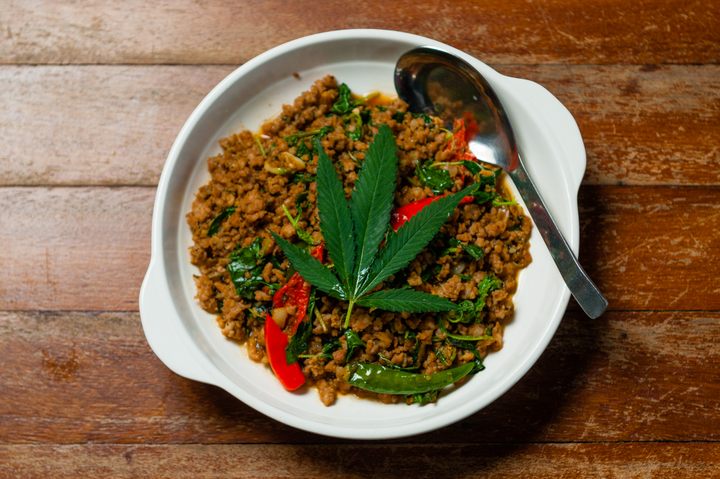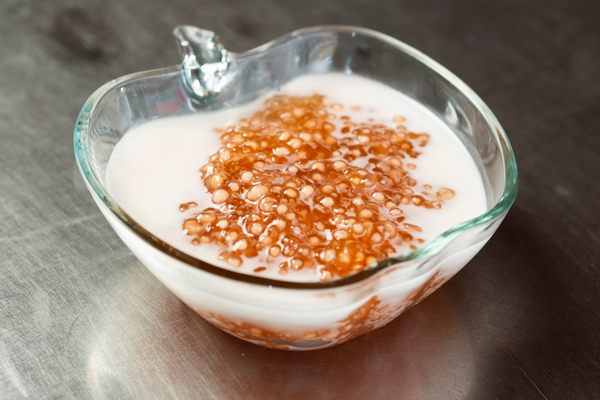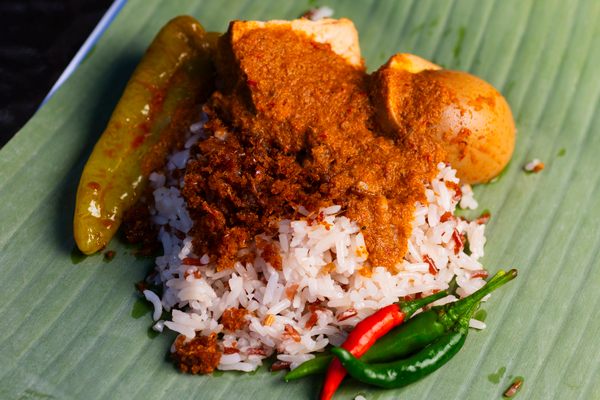

In Thailand, Traditional Cannabis Cuisine Is Back on the Menu
Cooking with marijuana is about umami and taste.
For a restaurant serving what was until recently a Class 5 narcotic substance, the clientele appeared older than one might expect: a couple of extended families, including grandma and grandpa; a woman having a quiet lunch with a man who appeared to be her father; a low-key middle-aged couple. Even the decor—cheesy knick knacks, thick curtains, antimacassars, antique crockery—was far from edgy.
The setting was Ban Lao Reung, a restaurant in Prachinburi, Thailand, that recently became the country’s first to serve dishes made with cannabis. On the day I visited, customers were digging into omelets garnished with marijuana leaves and sipping soups seasoned with dried cannabis-leaf powder. But only a few months ago, possession of these menu items would have led to a lengthy jail sentence, or a hefty bribe.
Thailand’s drug penalties are notoriously strict: The country has one of the largest prison populations in the world. Many are locked up because of drug offenses, and the death penalty remains a punishment for drug trafficking. But in 2018, the country’s military-led government surprised just about everybody when it announced that it would decriminalize marijuana for medical use, becoming the first country in Asia to do so. More recently, in late 2020, the junta announced that the parts of the cannabis plant that contain less than 0.2 percent tetrahydrocannabinol (THC, the psychoactive compound in marijuana), which includes the roots, stalks, stems, and leaves, could legally be used in cosmetics and food.

In Thailand, it’s possible to regard these recent laws as rectifications rather than revolutions. Marijuana became illegal in Thailand in 1934, but only as a result of international pressure, and Ban Lao Reung’s older clientele may be due to the fact that Thais have been using cannabis in their food for a very long time.
“My mom is 94, and she said that [cannabis] was used in the family since she was a kid,” says Sombat Kowtraul, the director of the community-outreach program linked to the restaurant. “Her parents used to send her to buy it at the market!”
Indeed, “tender ganja leaves” are called for in an eel-curry recipe in Mae Khrua Hua Pa, generally considered Thailand’s oldest cookbook, first printed in 1908. But it’s likely that the use of the plant goes back much, much earlier, with origins in medicine rather than food.

“Cannabis has been used as an herbal remedy as far back as the Sukhothai Kingdom [1239 to 1438],” says Dr. Waleerat Kraikosol, Deputy Medical Director of Chao Phraya Abhaibhubejhr Hospital, the country’s premier institution for traditional Thai medicine. “We used the entire plant—the leaves, the roots, the stems,” she says, adding that in the days before capsules, dried, ground up marijuana leaves were mixed with honey and eaten to encourage sleep. “Much later, people used cannabis in food such as noodle soups. It’s fragrant and it’s kind of like MSG, it improves taste.”
Mention marijuana to a Thai, and it’s quite possible she’ll think of noodle soup rather than blunts or bongs. Cannabis has been contraband for nearly a century now, but it’s still talked about in hushed tones as a secret ingredient in central Thailand’s famous boat noodles, and many a popular noodle soup vendor has been accused of adding “addictive” levels of the ingredient to the broth.
“My dad said that he used to use [cannabis] in the soup when I was a kid, at least 40 years ago,” says Sittichan Vuttipornkul, the second-generation owner of Rod Dee Ded, a noodle-soup restaurant with multiple branches in Bangkok. Was it for flavor? I ask. Aroma? Buzz? “I don’t think he understood what he was doing,” he says. “But science tells us that parts of the plant, especially the roots, have glutamic acid. This gives our tongues the ability to taste more flavor in food.”

Glutamic acid is an essential element in monosodium glutamate, commonly known as MSG. The amino acid enhances savory taste-active compounds, providing foods with a boost of umami, the pleasantly savory, “round” taste sometimes referred to as the fifth flavor. Research has revealed that the marijuana plant, in particular its leaves, contain a higher concentration of glutamic acid than Parmesan cheese, a food generally considered to have high levels of umami.
With the government’s recent announcement, Sittichai has been able to reintroduce marijuana to Rod Dee Ded’s noodle-soup recipe. He adds dried cannabis roots and branches, which were previously considered trash but now command sky-high prices, to the beef broth, while marijuana leaves, dry-roasted and ground to a subtly fragrant powder, are added to the optional condiments. “In the past, people didn’t have MSG, so they used [cannabis],” he tells me.
Similarly savory flavors are also headlining at Ban Lao Reung. Collaborating with traditional Thai medicine experts at Chao Phraya Abhaibhubejhr Hospital, the restaurant’s manager, Amara Akamanon, has created a menu of dishes that allegedly don’t include MSG, but that are positively packed with umami flavor: a savory stir-fry of minced pork, holy basil leaves, and dried marijuana leaves; a savory, tart, tom yam-like soup of pork, Thai herbs, and dried marijuana-leaf powder; and a downright meaty dish of fresh marijuana leaves, battered and deep-fried tempura-style, and served with a Thai-style dip.

These dishes are not edibles—you’d have to eat enormous portions to feel any kind of high. And the minute levels of THC in marijuna leaves only become active when exposed to heat, meaning that there’s absolutely no risk in slamming the restaurant’s refreshing (and highly Instagramable) drink that combines tea, passionfruit, and freshly juiced raw cannabis leaves, the latter with a vibrant green hue and a flavor like a milder wheat grass.
In the months since Ban Lao Reung debuted its menu, a handful of restaurants across Thailand have started serving marijuana-laced dishes ranging from mini pizzas to cannabis bubble tea. There’s inevitably a thrill in eating something that was only recently contraband, and that could potentially get one high. And medicinal marijuana proponents tout the alleged health benefits of cannabidiol, or CBD, present in these dishes. But when it comes to cooking with marijuana in Thailand, the main goal seems to be flavor, and there might be nothing more Thai than that.
Gastro Obscura covers the world’s most wondrous food and drink.
Sign up for our regular newsletter.































Follow us on Twitter to get the latest on the world's hidden wonders.
Like us on Facebook to get the latest on the world's hidden wonders.
Follow us on Twitter Like us on Facebook